Marsha Harrison-Mateer

Broker
Mobile: 705.440.9400
Phone: 705.435.3000
Selling you a home, not just a house,
with distinctive service that moves you!
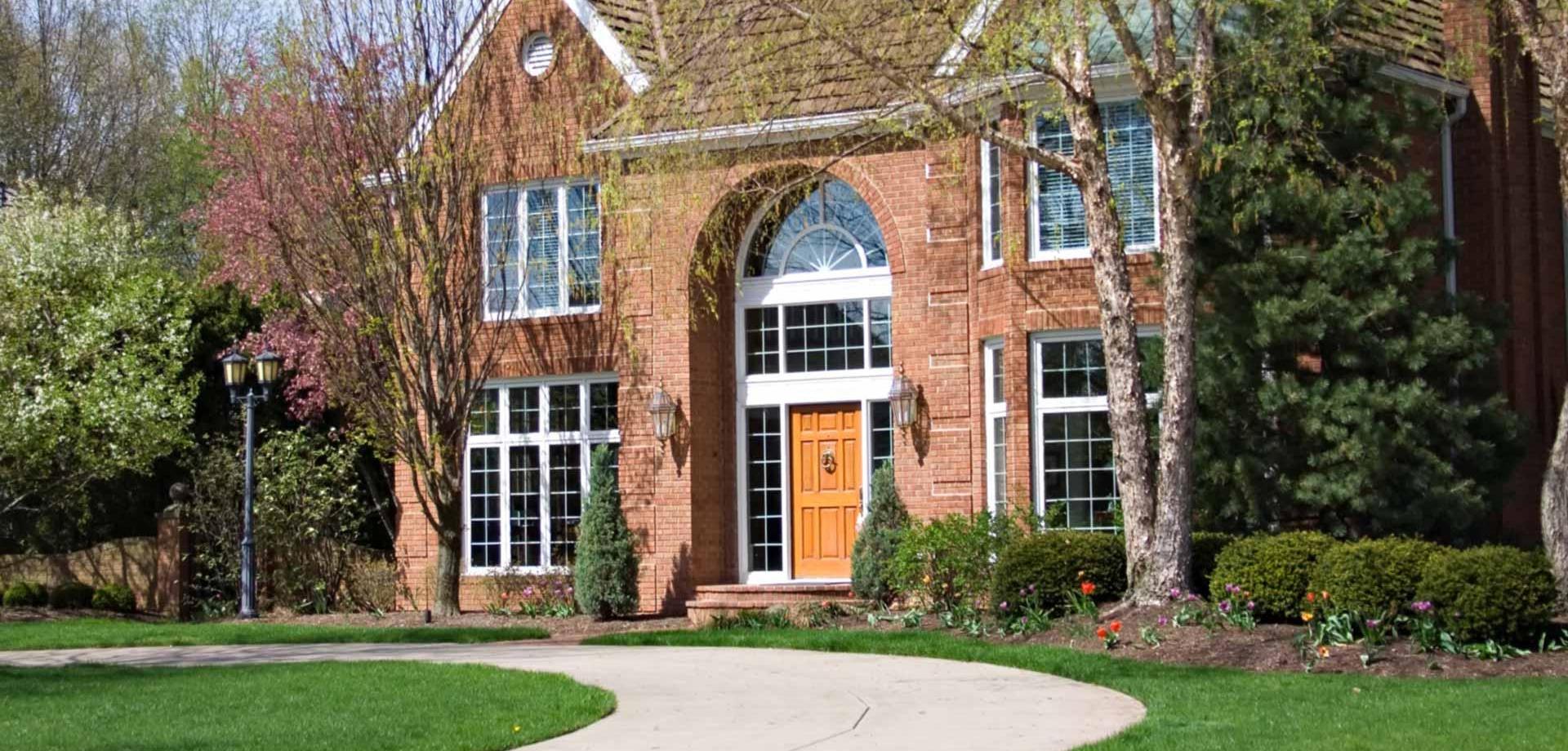


New Page

10Christmas Party Games
that are guaranteed to make you laugh while entertaining!
Naughty or nice, everyone loves a good party game—especially at Christmas.
1) Who Am I?
Write up a stack of cards with characters from traditional Christmas movies and TV shows. Every guest must pick one (no peeking!) and attach it to their back. They then must spend the night asking other guests questions to try to figure out which character they currently are. Game ends when everyone guesses!
2) Christmas Card Toss
Collect holiday cards as many as you like (15 is a good number). Place a good sized mixing bowl or basket in the middle of the room, about 6 feet away from the players. Have each player take a turn and try to toss the Christmas cards into the basket one by one. This is much harder than it seems at first and you will be surprised how those cards fly about! The winner is the one who gets the most cards in the basket after everyone has had a turn.
3) Oven Mitt Unwrap Game
Wrap the present in several layers of gift-wrapping paper.
Give one player a pair of oven mitts and the present, and the person on his/her left the cup with 2 dice. On “go” the player with the oven mitts puts them on and tries to unwrap the present one layer at a time. At the same time, the player with the dice rolls them until he/she gets doubles. Once doubles is rolled, the player passes the cup and dice to the player on the left, and takes over the oven mitts and present from the player on the right. Play continues with the items moving left each time doubles are rolled. The player who unwraps the final layer keeps the present.
4) Candy Canes (Holiday Spoons)
You’ll need a deck of cards and 3+ people circled around a pile of candy canes, one less than the number of players. Everyone takes turns pulling cards with the goal to be the first to get four of a kind (ex. four Kings). Once you do, take a candy cane as stealthily as possible. Once that happens, everyone else races to grab on of the remaining candy canes. The person who doesn't get a candy cane is eliminated. Do this until one winner remains.
5) Holiday Snowman
This is a hilarious and fun game that calls for two teams, one person being the representative to serve as "snowman". Each team will attempt to decorate a snowman with different hats, mittens, scarfs and decorations provided for the game. Set a time limit then vote who had the best snowman at the end!
6) Melting Ice
This game calls for two teams and an ice cube for each team. When the referee shouts ‘GO’! All participants will attempt to melt their ice cubes using only their hands!
Feel free to pass the ice cube between team members as much as you want! The first team to melt an ice cube of every member of their team will be declared the winners!
7) Snowman Stacking
How many snowmen can you stack with mini marshmallows in 1 minute? Set a timer and find out. Do this game in teams or as individual and watch the sabotage take over! What happens to your mini snowmen if some one bumps the table?
8) Gift Wrap Game
Challenge your party guests to see who can wrap a present the fastest. The catch? They must work in pairs and each person can only use one hand!
9) Face the Cookie
Place a cookie on someone’s forehead. They have to use only their face muscles (no hands) to get it into their mouth. The first person to get the cookie in their mouth without using their hands is the winner, if the cookie falls you're out.
10) Candy Cane Catch
Tie a piece of ribbon or twine from one chair or post to another. Players must stand on top of a chair and try to be the first to drop a candy cane from the chair onto the ribbon, hooking it on the ribbon and getting it to stay.

2023 Year-End Home Price Forecasts
While I cannot provide real-time data or predictions, I can give you an overview of factors that may influence home price forecasts for the year-end of 2023. The real estate market is influenced by various factors, including economic conditions, supply and demand dynamics, interest rates, and government policies. Here are a few key considerations:
Market Conditions: The overall strength of the housing market, including factors like job growth, consumer confidence, and population trends, can impact home prices. If the economy remains robust and demand for housing stays high, it could lead to price appreciation.
Inventory Levels: The supply of homes on the market plays a significant role in determining home prices. If there is a shortage of inventory, as has been the case in many markets in recent years, it can drive up prices. On the other hand, an increase in housing supply could potentially moderate price growth.
Interest Rates: Mortgage interest rates have a direct impact on housing affordability. Higher interest rates can reduce buying power and potentially slow down price growth. Conversely, lower interest rates can stimulate demand and support price appreciation.
Government Policies: Government initiatives, such as tax incentives, lending regulations, and housing programs, can influence the real estate market and impact home prices. Changes in policies related to housing could have implications for price trends.
It's important to note that the real estate market can be unpredictable and subject to unforeseen events or economic shifts. Therefore, it's always advisable to consult with local real estate experts or economists who can provide more accurate and up-to-date insights specific to your area. They can analyze local market trends and provide more accurate year-end forecasts based on the prevailing conditions in your region.

Gen Z: The Next Generation Is Making Moves in the Housing Market
Generation Z, born between the mid-1990s and early 2010s, is starting to make its mark in the housing market. Here are some ways this upcoming generation is influencing the real estate industry:
Homeownership Aspirations: Despite being younger, many Gen Z individuals already have aspirations of homeownership. They understand the value of investing in real estate and building equity over time.
Tech-Savvy Approach: Gen Z is the first generation to grow up with technology at their fingertips. They are comfortable using online resources, mobile apps, and social media platforms to search for homes, connect with real estate agents, and gather information about the market.
Sustainable and Energy-Efficient Homes: Gen Z places a strong emphasis on sustainability and environmental consciousness. They are more likely to prioritize energy-efficient features and eco-friendly materials when buying or renting a home. Builders and developers are taking note of this trend and incorporating green features into their projects.
Urban Lifestyle Preferences: Gen Z tends to lean towards urban living, valuing walkability, access to amenities, and proximity to work and entertainment. They are more likely to choose properties in urban areas or mixed-use developments that offer a live-work-play environment.
Demand for Affordable Housing: Affordability is a significant concern for Gen Z, given the financial challenges they face, including student loan debt. As they enter the housing market, they are seeking affordable options, such as starter homes, co-living arrangements, or homes in up-and-coming neighborhoods.
Flexible Living Spaces: Gen Z values flexibility and adaptability in their living spaces. They prefer open floor plans that can be easily customized to suit their needs and changing lifestyles. Homebuilders are responding by offering versatile floor plans that can accommodate various uses.
Real estate professionals should pay attention to the preferences and needs of Gen Z as they become an increasingly influential force in the housing market. Adapting marketing strategies to reach this generation, leveraging technology, and understanding their unique preferences can help real estate agents connect with and serve Gen Z buyers and renters effectively.

Winter Holiday's are Coming
do a good deed a day starting in December!
With Christmas a month away, it's time to start thinking about holiday gatherings, treats and, of course, the holiday spirit. One way to spread the spirit of the season is by spreading random acts of kindness in your community.
Here are 25 Act that can get you in the festive mood:
1. Pay for someone's coffee in line
2. Donate food items to the local food bank
3. Make cupcakes for a women’s shelter
4. Pick 5 friends on social media and post something nice about them on their wall
5. Donate blood
6. Buy flowers for your neighbour
7. Create a care package and send to a Canadian Forces Member
8. Help shovel snow for an elderly neighbor OR if there’s no snow, offer to buy groceries for them so they don’t have to go out into the cold
9. Leave an inspiring book somewhere (bus or on a park bench) for someone to read. Write a nice message to the next reader on the cover.
10. Ask your friends and family to donate $5 to a charity of your choice
11. Buy flowers for the nurses at your local hospital
12. Drop off muffins or cupcakes to a fire station
13. Promote a charitable organization on your social media
14. Give someone a hug
15. Become pen pals with someone who needs a chat
16. Donate your old winter clothes to charity
17. Donate your old cell phones (The Canadian Hearing Society, Call2recycle.ca)
18. Pick a random name from the phone book and mail them a Christmas card (Bonus: Include a coffee card!)
19. Surprise a friend with dinner at their door
20. Compliment three people today
21. Bake some cookies and share with your co-workers
22. Contact an animal shelter and find out how you can help
23. Surprise your neighbour with holiday treats
24. Donate toys to a holiday toy drive
25. Go into a convenience store or gas station and give the clerk a present

Less Expensive Homes are in Demand
The demand for less expensive homes has been on the rise, and builders are indeed responding to this market trend. As more people look for affordable housing options, builders are adapting their strategies and offerings to meet this demand.
There are several reasons why people are seeking less expensive homes. Affordability is a key factor, as many individuals and families are looking for housing options that fit within their budget. Additionally, with the impact of the COVID-19 pandemic, there has been a shift towards remote work and a desire for more space, which has also influenced the demand for affordable homes.
Builders are addressing this demand by focusing on smaller, more cost-effective housing options. This includes constructing townhomes, condos, and smaller single-family homes. These types of properties not only provide more affordable options but also tend to require less maintenance and offer a more convenient lifestyle.
In addition to downsizing the size of homes, builders are also incorporating more energy-efficient features and sustainable materials. This not only reduces the overall cost of homeownership but also aligns with the growing interest in eco-friendly living.
Furthermore, builders are looking to develop in areas where land costs are lower, allowing them to offer more affordable homes. This may include expanding into suburban or rural areas that offer more affordable land prices compared to urban centers.
Overall, the shift towards less expensive homes is a response to the changing needs and preferences of homebuyers. Builders are adapting their strategies to provide more affordable options that meet the demands of today's market.

13 Ways to Keep Up Your Curb Appeal in Winter
Just because the days are dark and gray doesn't mean you can't dress up your home a bit. It doesn't matter if you're selling your home or you just want your home to look great for the holidays, here are 13 ways to spruce up the outside of your home this winter.
Add a Small Tree
This holiday season, buy an extra small Christmas tree (or two!) to place near the front door. You can wrap the bottom of the tree with some burlap or place it in a basket. If you have and electrical outlet nearby, add a string of lights.
Create a Warm Glow
Exterior lighting not only makes your home safer, it also makes your home look cozy and inviting. Take a walk around the outside of your home to make sure all lights are working properly and check for any bulbs that need to be replaced. Also, check to make sure bulbs are clear of ice and snow.
Clear the Snow
Nothing makes a home look unkempt in the winter faster than snow that hasn’t been cleared. Take the time to shovel the front walkway and shovel or use the snowblower on the driveway to keep paths clear and safe.
Add Some Plants
Look for some cold-weather plants to add to your front entryway. Think evergreens or plants with colorful berries to add some interest to an otherwise drab space.
Clear Clutter
Make sure all toys, shovels and lawn equipment are put away after use. Leaving items like this laying around is a quick way to give your yard a sloppy look.
Try a Lantern
Hang a lantern on a post near your entryway or set one or two on the steps for a charming, welcoming look. Lanterns can be either hard-wired or battery-operated.
Add Some Color and Shine
Winter can be dark and gloomy so add some shine to up your curb appeal. Pick out some shiny, colorful garden ornaments to add around the front of your home.
Use String Lights
String lights aren’t just for the holidays. Try using them in a clear glass bowl or lantern on your porch for a soft glow or suspend them from a tree for an enchanting look.
Hang a Wreath
Wreaths don’t have to be super-fancy or really large. Think beyond evergreen and choose a wreath with understated elegance.
Attract the Birds
Add a colorful bird feeder in your front yard. A well-placed feeder adds color and life to an otherwise gray landscape.
Get Painting
Break from the expected and go for a bold color on your front door. The pop of color may be just what your home needs during the depths of winter.
Update Your Mailbox
If your mailbox is boring black, brown or white, give it a winter makeover. Try some brightly colored paint to help boost your curb appeal. Just bring it inside to warm up since paint has a hard time adhering to cold surfaces.
Replace House Numbers
Up your home’s curb appeal with some striking new house numbers. Go for a design that makes a statement. Or, find a style that speaks to your home’s character. Just make sure they can easily be spotted from the street.
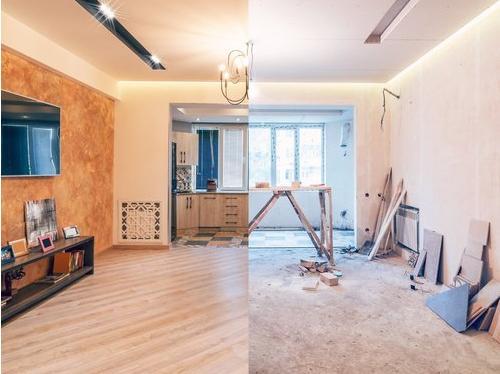
Essential Home Repairs: A Guide for Homeowners
Keeping a home in good condition requires regular maintenance and occasional repairs. As a homeowner, understanding the essential home repairs can save you time, money, and potential headaches down the road. In this blog post, we will explore some common home repairs that every homeowner should be familiar with.
Plumbing Repairs: A leaky faucet, clogged drain, or running toilet are common plumbing issues that homeowners encounter. Knowing how to fix these minor plumbing problems can prevent water wastage and avoid costly repairs. We will discuss simple solutions and when to call a professional plumber.
Electrical Repairs: Faulty wiring or malfunctioning electrical fixtures can be dangerous and should be addressed promptly. We will provide guidance on basic electrical repairs, such as replacing a light switch or installing a ceiling fan. However, it's important to emphasize the importance of hiring a licensed electrician for complex electrical work.
Roof Repairs: A well-maintained roof is crucial for protecting your home from the elements. From replacing damaged shingles to fixing leaks, we will discuss some common roof repairs that homeowners may encounter. We will also highlight the importance of regular roof inspections to identify potential issues before they become major problems.
HVAC Repairs: A properly functioning heating, ventilation, and air conditioning (HVAC) system is essential for maintaining a comfortable indoor environment. We will provide tips on troubleshooting common HVAC problems, such as uneven cooling or heating issues. However, it's important to note that complex HVAC repairs should be left to certified technicians.
Structural Repairs: Over time, homes may experience structural issues, such as foundation cracks or sagging floors. We will discuss signs of potential structural problems and provide guidance on when to seek professional help. It's crucial to address these issues promptly to prevent further damage and ensure the safety of your home.
Bottom Line
By familiarizing yourself with essential home repairs, you can become a proactive homeowner and tackle minor issues before they escalate into major problems. Remember, while some repairs can be handled independently, it's important to recognize when it's time to call in a professional. Regular maintenance and prompt repairs will not only keep your home in good condition but also help preserve its value in the long run.

Fall Home Tips: Prepare Your Property for the Changing Season
As the leaves change color and the temperature drops, it's time to prepare your home for the fall season. From maintenance tasks to cozy decor ideas, these fall home tips will help you create a warm and inviting atmosphere for potential buyers and ensure that your property remains in top condition. Take advantage of this seasonal shift and make the most of your real estate opportunities. Read on for some essential tips to get started.
Exterior Maintenance: (a.) Clean the gutters: Remove leaves and debris from your gutters to prevent water damage and potential clogging. (b.) Inspect the roof: Check for any loose or damaged shingles and address any necessary repairs. (c.) Trim trees and shrubs: Prune overgrown branches to prevent them from causing damage during storms.
Prepare the Yard: (a.) Rake the leaves: Keep your yard well-maintained by raking fallen leaves regularly. (b.) Plant seasonal flowers: Add pops of color to your front yard with fall flowers such as mums or pansies. (c.) Store outdoor furniture: Protect your outdoor furniture by storing it properly or covering it with weatherproof covers.
Cozy Interior Updates: (a.) Warm color palette: Embrace the fall ambiance by incorporating warm hues such as deep reds, burnt oranges, and earthy browns into your home decor. (b.) Layered textiles: Add cozy throw blankets, plush rugs, and textured pillows to create a welcoming and inviting atmosphere. (c.) Fall-inspired scents: Use scented candles or diffusers with fragrances like cinnamon, pumpkin spice, or apple cider to create a comforting aroma.
Energy Efficiency: (a.) Check windows and doors for drafts: Seal any gaps or cracks with weatherstripping or caulking to prevent heat loss and save on energy bills. (b.) Insulate pipes: Protect your pipes from freezing temperatures by insulating them with foam sleeves. (c.) Schedule a heating system check-up: Ensure that your heating system is in good working condition before the colder weather arrives.
Safety Measures: (a.) Test smoke and carbon monoxide detectors: Replace batteries and ensure these devices are functioning properly. (b.) Check fire extinguishers: Make sure your fire extinguishers are up to date and easily accessible. (c.) Install outdoor lighting: As daylight hours decrease, consider installing motion-sensor lights for added safety and security.
Bottom Line
By following these fall home tips, you can create an inviting and cozy atmosphere while also ensuring that your property is well-maintained and prepared for the changing season. With a little effort and attention to detail, you can attract potential buyers and make a lasting impression. Embrace the fall season and make your property shine in the real estate market.
Remember, I'm here to assist you with any further questions or real estate-related topics. Happy fall preparations!

How to Throw an Unforgettable Housewarming Party
Moving into a new home is an exciting milestone worth celebrating, and what better way to do it than by throwing a memorable housewarming party? Not only does it give you a chance to show off your new space, but it's also an opportunity to gather friends, family, and new neighbors to create lasting memories. In this blog, we'll provide you with tips and ideas to help you host an unforgettable housewarming party that will leave your guests impressed and excited to see your new home.
Plan Ahead: Set a date and time: Choose a date that gives you enough time to settle into your new home but is also convenient for your guests. Create a guest list: Decide who you want to invite—friends, family, neighbors, or a combination—and send out invitations well in advance.
Theme and Decor: Choose a theme: Consider a theme that reflects your personal style or the ambiance of your new home, such as a rustic farmhouse, beachy vibes, or a cozy autumn theme for a fall housewarming party. Decorate with flair: Use decorations that match your chosen theme, such as table centerpieces, wall hangings, and themed party favors.
Food and Drinks: Plan the menu: Decide on the type of food you want to serve—whether it's a buffet, a sit-down dinner, or a casual finger food spread. Consider dietary restrictions and preferences of your guests. Signature drinks: Create a signature cocktail or mocktail that represents your new home or the theme of the party.
Entertainment and Activities: House tours: Give your guests a guided tour of your new home, highlighting its unique features and design elements. Games and activities: Set up interactive games or activities to keep your guests engaged and entertained. You could have a DIY craft station, a photo booth, or even a trivia game about your new neighborhood.
Personal Touches: Create a memory wall: Set up a designated space where guests can leave a message or sign their names as a keepsake. Party favors: Prepare small tokens of appreciation for your guests to take home, such as personalized keychains or a small potted plant.
Safety and Comfort: Safety first: Ensure your home is safe and accessible for your guests. Clear any potential hazards, provide ample lighting, and have a first aid kit on hand. Consider seating and space: Make sure you have enough seating and create cozy areas for guests to mingle and relax.
Bottom Line
A housewarming party is a wonderful way to celebrate your new home and share the joy with loved ones. By planning ahead, incorporating a theme, and adding personal touches, you can host an unforgettable housewarming party that will leave a lasting impression. Enjoy this special occasion and make cherished memories in your new home!
If you need further assistance or have any other real estate-related queries, feel free to ask. Happy housewarming!

Should you go to an open house, even if you are not in the market?
With all of the listing sites available, browsing homes online can become addictive. Even if you’re not in the market to buy or sell a home, you may find yourself scanning the internet for homes that you do not intend to buy or are completely out of your price range. Not only does this help past the time, but it’s also an exhilarating pastime.
Instead of just perusing the web for a home, why not visit them? If you think you need a realtor to go to an open house or you have to be in the market to buy a home to attend, think again. Attending an open house can be a beneficial endeavor for your future home buying experience. So before you discount the idea, here are a few things to consider.
Is it okay to attend an open house without a realtor?
The first thing that may deter you from going to an open house is that you think you need to go with an agent. While many buyer’s agents recommend booking with them ahead of time to visit a home, realtors are used to prospective buyers stopping by open houses all the time. An open house allows prospective buyers to see what’s available without any pressure to buy. So, if you’re not ready to partner with an agent, it’s completely okay to attend open houses alone.
Discover what you can afford
The homes you’re attracted to and what homes you can afford might be two completely different things. Often, first-time homebuyers don’t get a good idea of what they can afford until they are deep into the home-buying process. They might be searching for something that doesn’t even exist. Therefore, the sooner you can understand what type of homes are available within your price range, the better chance you have of successfully finding a home that matches your expectations and budget.
Visiting open houses can help you discover what you can and cannot afford. While you can type in a price range online, the photos and experience of visiting the home might be quite different from the listing. Getting up close and personal with homes that may interest you will give you a better idea of what to expect when you start the home-buying process. This way, you won’t be disappointed and discouraged when you start looking for your perfect home.
Check out the competition
The number of guests attending an open house can indicate how fast you need to make an offer when you find a home you’re interested in. It can also tell you how you need to price your home to have it sell quickly. While some housing markets can allow a few days to make a decision, others may only give you a few hours to submit your offer. If you pay close attention to the other buyers at the open house, you may gather some intel about what type of home buyer the seller is looking for. Even though this may not matter now since you don’t intend to purchase the home, it may help you later when you’re ready to submit an offer. The more information you can gather, the better you’ll be able to navigate your home-buying process.
See realtors in action
Even if you don’t identify the home of your dreams, you might be able to connect with a realtor who can help you find your dream home. Visiting open houses gives you the perfect opportunity to interview candidates, without them even knowing you are looking for an agent. This gives you the ability to see how different realtors represent their clients and if they might be suitable for your needs. Be aware of how the realtor interacts with you upon your arrival. Do they greet you, or are they too busy to give you the time of day? You should also come with insightful questions about the market to determine how knowledge the agent is.
Observe home design trends
Generally, sellers try to make a great first impression when hosting an open house. Some sellers may even make some updates or hire a staging company before they list their home. Sellers tend to rely on the guidance of their realtor or the design trends happening within the market. Therefore, when you attend an open house, you can get an idea of what home designs you’ll see. It will give you an idea of what you’re attracted to and things you may look for when buying a home. Also, it may give you some inspiration for updates to your current home that will make it feel like new.
Get familiar with neighborhoods that interest you
Buying a home is about more than the property itself. It’s important to find a home and community that suits your lifestyle. For example, if you want to start a family, you may want to buy a home in a good school district with parks close by. Therefore, this is the perfect time to start learning about nearby communities that could be a match for your needs. You can begin by observing the residents and vibe of the communities you’re interested in a few months before you start the home buying process.
Learn more about your needs
Often, it’s challenging to know what you truly want in a property before you start searching for a home. For instance, how many bedrooms do you want? Are you okay with a first-floor master? What amenities are you looking for? Viewing other homes will give you an idea of different layouts and amenities that interest you.
The bottom line, sure, you may feel nosey or that you’re intruding with out the intention of buying. However, regardless of whether you’re buying or selling a home, you should visit a few open houses. You don’t need to bring a realtor. Just hop in your car or take a walk down the street to get a better idea of what you can afford and what homes make sense for your lifestyle.

Preparing Your Home for Fall: Essential Tips and Tricks
As the leaves begin to change colors and the temperature starts to drop, it's time to prepare your home for the upcoming fall season. Whether you're a homeowner looking to create a cozy and inviting atmosphere or a real estate agent helping clients get their homes ready for potential buyers, this blog post will provide you with essential tips and tricks to prepare your home for fall.
Clean and Declutter: Start by giving your home a thorough cleaning. Remove any summer clutter and organize your belongings. This not only helps create a fresh and orderly environment but also allows you to make space for fall decorations and seasonal items. Don't forget to clean your windows to let in as much natural light as possible during the shorter fall days.
Check Your Heating System: Before the colder weather sets in, it's a good idea to have your heating system inspected and serviced by a professional. Clean or replace air filters, check for any leaks or issues, and ensure that your heating system is functioning properly. This will not only keep your home comfortable but also help save on energy costs.
Inspect and Clean Chimney and Fireplace: If you have a fireplace, fall is the perfect time to get it ready for use. Hire a professional chimney sweep to inspect and clean your chimney. This will help remove any built-up soot or debris and ensure that your fireplace is safe and ready to provide cozy warmth during the cooler months.
Seal Windows and Doors: To keep your home warm and energy-efficient during fall, check for any drafts around windows and doors. Apply weatherstripping or caulking to seal any gaps and prevent cold air from entering and warm air from escaping. This simple step can significantly reduce heating costs and create a more comfortable living environment.
Prepare the Outdoor Space: Fall is a great time to enjoy your outdoor space, so prepare it accordingly. Clean and store summer furniture, cushions, and accessories. Consider adding cozy elements such as blankets, throw pillows, and outdoor heaters to make your outdoor area inviting and usable even as the temperatures drop.
Decorate with Fall Accents: Embrace the season by adding fall accents and decorations to your home. Incorporate warm and earthy colors, such as oranges, yellows, browns, and deep reds, into your decor. Display pumpkins, gourds, fall wreaths, and seasonal flowers to create a welcoming and festive atmosphere.
Bottom Line
Preparing your home for fall is all about creating a comfortable and welcoming environment while also ensuring that your home is ready for the changing weather. By cleaning and decluttering, checking your heating system, inspecting and cleaning your chimney, sealing windows and doors, preparing the outdoor space, and adding fall accents, you can make your home cozy, energy-efficient, and ready to embrace the beauty of the autumn season. So, grab a pumpkin spice latte, put on your favorite sweater, and get ready to enjoy the comforts of fall in your well-prepared home.

The Importance of Roof Maintenance: Tips for Homeowners
The roof is one of the most critical components of a home, providing protection from the elements and maintaining structural integrity. Regular roof maintenance is essential to prolong its lifespan and prevent costly repairs. In this blog post, we will explore the importance of roof maintenance and provide helpful tips for homeowners to keep their roofs in optimal condition.
Regular Inspections: Performing regular roof inspections is crucial to identify any signs of damage or wear. Inspect for missing or damaged shingles, cracked flashing, sagging areas, or signs of water leakage. Schedule professional inspections at least once a year, especially after severe weather events, to catch potential issues early.
Clean Gutters and Downspouts: Clogged gutters and downspouts can lead to water buildup on the roof, causing damage to the shingles and potential leaks. Regularly clean out debris from gutters and ensure downspouts are properly directing water away from the foundation. Consider installing gutter guards to prevent debris buildup.
Trim Overhanging Trees: Overhanging tree branches can scrape against the roof, causing damage to shingles and creating entry points for pests. Trim back any branches that are in close proximity to the roof to prevent potential damage and maintain proper airflow.
Address Roof Leaks Promptly: If you notice any signs of water leakage, such as water stains on the ceiling or damp spots in the attic, address the issue promptly. Roof leaks can lead to significant damage, including mold growth and compromised structural integrity. Contact a professional roofer to assess and repair the source of the leak.
Maintain Proper Attic Ventilation: Proper attic ventilation is crucial for preventing excess heat and moisture buildup, which can damage the roof structure and shingles. Ensure that attic vents are clear of obstructions and consider installing additional vents if needed. Consult with a professional to assess your attic ventilation needs.
Prevent Ice Dams: In colder climates, ice dams can form on the roof edges, leading to water penetration and damage. Proper insulation and ventilation in the attic can help prevent ice dams. Additionally, safely remove accumulated snow from the roof to minimize the risk of ice dam formation.
Hire Professional Roofers: For major repairs or roof replacements, it's essential to hire professional roofers with expertise in the specific type of roofing material. They can ensure proper installation and provide guidance on maintenance practices to prolong the roof's lifespan.
Bottom Line
Regular roof maintenance is crucial for protecting your home and preserving its value. By following these tips and investing in regular inspections and repairs, homeowners can extend the lifespan of their roofs and minimize the risk of costly damage. Remember, when in doubt, consult with a professional roofer to ensure proper care and maintenance of your roof.

The Cost of Selling on Your Own
Selling a property on your own, also known as "For Sale By Owner" (FSBO), can be an appealing option for homeowners looking to save money on real estate agent commissions. However, it's important to understand the costs involved in selling on your own, as they can add up and potentially outweigh the savings.
Marketing and Advertising: When selling on your own, you'll need to invest in marketing and advertising your property. This can include professional photography, virtual tours, online listings, signage, brochures, and more. These costs can vary depending on the level of exposure you want for your property.
Time and Effort: Selling a property requires a significant amount of time and effort. As a FSBO seller, you'll need to handle all aspects of the selling process, including scheduling and conducting showings, negotiating offers, managing paperwork, and coordinating with potential buyers. Consider the value of your time and whether it's worth the savings to handle these tasks yourself.
Legal and Documentation: Selling a property involves various legal and documentation requirements. You may need to hire an attorney to review contracts, ensure compliance with local regulations, and handle any legal issues that may arise. These costs can vary depending on your location and specific needs.
Lack of Market Knowledge: Real estate agents have extensive knowledge of the local market, pricing trends, and comparable sales. Without this expertise, you may have difficulty setting the right listing price for your property, potentially leading to a longer time on the market or selling for less than its true value.
Negotiation Skills: Negotiating with buyers can be a challenging aspect of selling a property. Real estate agents are experienced negotiators who can help you get the best possible price and terms. Without this expertise, you may find it difficult to navigate negotiations effectively.
Limited Exposure: One of the main advantages of working with a real estate agent is the exposure they can provide through their network, online platforms, and marketing efforts. As a FSBO seller, you may have limited access to potential buyers, resulting in reduced demand and potentially a longer selling process.
It's crucial to carefully consider these costs and potential challenges before deciding to sell on your own. While it's possible to save on agent commissions, selling a property without professional assistance may not always be the most cost-effective or efficient option.
Have questions? I'm happy to help!

Home Renovations on a Budget
If you took a peek at a new homeowner’s search history, you’d likely find key terms like, “Home renovations on a budget,” “How much does it cost on average to do A, B, C,” or “Cheap hacks to fix blah, blah, blah…” New homeowner or not, it’s safe to say that anyone who’s has taken a trip to their local Lowes or Home Depot as of late, has had to pick their jaw up off the floor when faced with the monumental price increases of everything from lumber to plumbing and even the snack size can of Pringles you have to have while standing in line for the self-checkout. “I can store nails or something in the can afterward,” you tell yourself. Yeah, sure...
So, is renovating on a budget even possible these days? Well, yes. After all, a budget is going to vary from person to person. Even in a general sense, there are decisions you can make to cut corners and save cash without compromising the quality or safety of your project.
DIY
If you can do it, save money by foregoing professional installation. If you’ve always wanted to learn how to install a wall outlet, fix a sink trap, tile a mudroom, or replace the crumbling drywall in the den, there are pages of YouTube videos explaining how to do just that. Also, if you visit the website of your favorite hardware or big box store and search for some of the materials needed to complete your project, you can occasionally find installation tutorials right on the product page.
Bargain Shop
You’ve elected to tackle the project yourself, but the cost of the available materials has you burying your head into a tear-soaked pillow and screaming, “Why me?” not. Just because the last million-dollar home you visited featured imported Italian marble tiles in the entryway doesn’t mean you have to or need to spend that much money. Measure the length and width of the room and multiply those numbers together. That gives you the square footage. See how much square footage each box of hardwood, vinyl, or laminate you intend to buy is supposed to cover. If a box covers 14 sq ft and you have 144 sq ft to cover, you’ll need just 10.2 boxes. So, buy 11. No, buy 12. You see, you should always buy 1 more additional box than accounted for to cover your mistakes.
Don’t Fall Prey to Brand Names
You can afford what you can afford. Minimum grade underlayment is the minimum grade, which is to say it will work just fine! It’s perfectly acceptable and will keep you under budget. The last thing you want to do is spend double what you paid for your flooring to lay it. Most vinyl and laminate plank flooring requires nothing more than a circular saw, pencil, straight edge, rubber hammer, and a small block of wood to bump and lock the pieces together. Don’t buy a fancy kit because Chip and Joanna put their faces on it. Oh, and don’t forget to check Craigslist or Facebook Marketplace for deals on materials someone else is trying to unload for much less than they probably paid for it.
Defer to the Experts
You know who I’m talking about. Put that old guy or gal to work. Mine’s pushing 80 and just spent the last 3 days cutting copper pipe, loading plywood into a Lowes rental truck, and maneuvering drywall in an 8x7 bathroom. You can consult someone with a fancy schmancy certificate that allows them to charge you $50 an hour to point a flashlight or you can ask someone you know and trust if they’ll take payment in cheeseburgers or beer. Look, there are times where you should absolutely hire an expert but that comes with a cost. Ask someone older, wiser, or more experienced than you how to install a new lighting fixture before you shell out a house payment for the privilege of playing trivia games on your phone while someone else does it and you learn nothing.
If you’re a new homeowner, the thought of becoming your own maintenance person, roofer, plumber, electrician, and landscaper can be a little distressing. Just think of the memories you’ll make as your sister shows you how to wallpaper while you’re on an 8-foot ladder with its legs centimeters from the top of the stairs. Priceless.
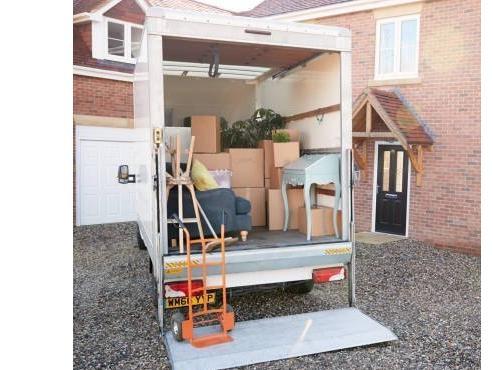
Top 10 Reasons to Buy a Home
Why should you buy a home? Well, it’s hard to say without knowing a few details about your individual situation, but the below list will seek to cover some of the best reasons one might decide to become a homeowner.
10. It’s yours.
Seems simple enough but think of the greater implications of that particular statement. If you want to paint zebra stripes on your wall, turn your garden shed into an Airbnb, or do laundry at 3 a.m., there will be no one to stop you. It’s your home. Your investment.
9. Personal Finance.
Most first-time homebuyers are astounded to learn just how little money is truly needed to get to the closing table. There are so many different programs, loans, and services to help first time buyers succeed in their goal of homeownership, without the need of the assets or equity that a seasoned buyer might have at their disposal. There’s also the cost of the monthly mortgage payment itself. Another shocking revelation for a lot of people is the fact that their mortgage payment is often comparable or even less than a month’s rent. Plus, you’ll have the benefit of a fixed rate, so you don’t have to worry about a large increase in your monthly payment. Yes, you might have to cut the grass and you’ll be on the hook for repairs but any work or improvements you do to the home are likely to work in your favor on a resell. When you rent, you’re essentially making someone else’s mortgage payment. This means you get neither the risk nor the reward of ownership.
8. Its investment potential.
We may have touched on this a little in the previous couple paragraphs, but it bears repeating: when you make improvements to a property you own, you’re setting yourself up for a bigger payout down the line if you choose to rent out or sell. Whether you’re buying your primary residence, a potential rental, or a flip, there’s a lot of opportunity to build equity and personal wealth.
7. The market is right for it.
There are simply times in history where buying is the absolute best decision you can make. Let’s look at interest rates for example. The average interest rate for a 30-year loan is hovering at around 7% right now. Yes, that’s higher than where things were this time last year. However, it’s still much lower than the historical high of just under 19%, in 1981. In the year 2000, they were at about 8.5%. Worst case scenario: pay your mortgage on time, build some equity, and carefully manage your consumer credit and you can always refinance for a lower percentage rate later on.
6. It’s the right time in your life.
If you’ve been thinking about buying a home for some time, it feels right, and you have the means and support to do so, why not? Your local trusted REALTOR can help you address any lingering questions and concerns you may have. Even if you’re not ready to say, “yes,” why not see what’s available? You have nothing to lose.
5. You need more space.
If you own your property, you won’t have to fight for a parking space or access to extra storage for items inconvenient to store in your unit like a bicycle, motorcycle, kayak, ladder, etc. Plus, if you’re marrying, taking a roommate, or expanding your family, you might need an extra bedroom or two. Find the home that best suits your needs while keeping your monthly expenses under budget.
4. It’s an experience.
While it may seem irresponsible to make such a large purchase purely for the experience of doing so, you can certainly learn a lot from homeownership. If you’ve always wanted to try your hand at drywalling, stone masonry, carpeting, minor electrical and plumbing, painting, flooring, roofing, decking, or landscaping, there’s a good chance you’ll be getting acquainted with a little bit of all of it in your first home! The good news? You learn some new skills or at least enough to patch things up while waiting for the professionals to do a proper fix. Of course, if you get really good at something you can save money with a little old- fashioned DIY. Owning a home almost certainly guarantees a unique and rewarding experience.
3. Stability.
Maybe you’re just tired of moving or you really want to settle down in one place and build a stable life. You might be tempted to relate homeownership to an anchor, keeping you held in place, but what if you want to be held in place? If you like the neighborhood, you like the town, or you just adore the house and you can see yourself living there when you’re 25 and when you’re 85, maybe it’s time to commit to it. No one really knows what life has waiting around the corner and there are always refinancing or selling options. However, if all things go according to plan and you can’t stand the thought of toting your vinyl record collection up another set of stairs, there’s nothing wrong with settling down.
2. The available support.
There are a lot of great REALTORS and support tools out there to help you assess your homebuyer priorities. Sometimes, just speaking to the right person can be enough to help you make a decision one way or another. They’ll show you the ins and outs of homeownership and connect you with affiliates who provide services in financing, settlement, closing, and insurance. When you’re your own personal advocate, the process can feel tedious, daunting, even impossible. Getting that critical support might be all it takes to change your mind about everything.
1. The market is coming back, big time.
That’s right. Don’t let the unprecedented market fluctuations that have defined the post-Covid era deter you from achieving your goal of homeownership. It’s not 2021 anymore. Buyers began to hesitate as homes entered and left the market in hours with offers well above asking price. What we’re seeing now is a market correction of sorts. Homebuyers are much more likely to have successful bids. If projections hold true, the market is going to take off toward the end of the year. Why wait until then when competition is up again? If you’ve been thinking about making a move, the board is all yours.

The True Value of Homeownership
Buying and owning your home can make a big difference in your life by bringing you joy and a sense of belonging. And with National Homeownership Month just passed us, it’s the perfect time to think about all the benefits homeownership provides.
Of course, there are financial reasons to buy a house, but it’s important to consider the non-financial benefits that make a home more than just where you live.
Here are three ways owning your home can give you a sense of accomplishment, happiness, and pride:
You May Feel Happier and More Fulfilled
Owning a home is associated with better mental health and well-being. Studies have shown the emotional and psychological benefits that homeownership has on a person’s health and self-esteem. According to Habitat for Humanity, Residential stability among homeowners is related to improved life satisfaction, along with better physical and mental health.
So, according to the experts, owning a home can improve your psychological wellness by making you feel happier and more accomplished.
You Can Engage in Your Neighborhood and Grow Your Sense of Community
Your home connects you to your community. Homeowners tend to stay in their homes longer than renters, and that can help you feel more connected to your community because you have more time to build meaningful relationships. When people stay in the same area for a longer period of time, it can lead to them being more involved: Homeowners also tend to be more active in their local communities.
After all, it makes sense that someone would want to help improve the area they’re going to be living in for a while.
You Can Customize and Improve Your Living Space
Your home is a place that’s all yours. When you own it, unless there are specific homeowner’s association requirements, you’re free to customize it however you see fit. Whether that’s small home improvements or full-on renovations, your house can be exactly what you want and need it to be. As your tastes and lifestyle change, so can your home. One major benefit of homeownership is the knowledge that you own your little corner of the world. You can customize your house, remodel, paint, and decorate without the need to get permission from a landlord.
Renting can limit your ability to personalize your living space, and even if you do make changes, you may have to undo them before your lease ends. The ability homeownership gives you to customize and improve where you live creates a greater sense of ownership, pride, and connection with your home.
Owning your home can change your life in a way that gives you greater satisfaction and happiness. Let’s connect today if you’re ready to explore homeownership and all it has to offer.

What Type of Home is Right For You?
There’s a lot to consider when buying a home. You’ve probably asked yourself a million questions already. What’s in my budget? What will my annual tax bill look like? How far am I willing to commute? How are the schools? Of course, that’s all incredibly important. Particularly if you think it might be your forever home.
The next question most people will ask, or should be asking, is what kind of home is right for me? Single family? Condominium? Townhouse? Chateau in the French countryside? So many questions! Over the next few paragraphs, we’ll examine what types of residences, including the most common architectural styles, are available right now to you, the homebuyer.
First, let’s tackle single-family homes. Single-family homes are usually defined as free standing or detached residential structures. There’s some leeway there where properties can be seemingly attached but separated by a wall that extends the full vertical height of the home, roof excluded. As one can imagine, there’s a lot of variety in single-family homes. Several are listed below.
Ranch
A ranch-style home is a single level home. They’re most usually wider than they are tall. There are many reasons to prefer to single level living, including: you don’t want to carry furniture upstairs, you have mobility concerns that make routine stair climbing inconvenient, and/or you prefer an open floor plan that allows you to flow from one end of the square footage to the other without ascending or descending stairs or other obstructions.
Cape Cod
Cape Cods also tend to be single level but not always. This style is most known for its rectangular structure with a side roof that sits lower than the main roof. They’re also known for their compact design so don’t expect vaulted ceilings or oversized rooms. Most rooms are built off a central point in the house, usually a fireplace.
Victorian
If you’ve always dreamed of a library with a sliding ladder, stained glass, a sharp roof, and sprawling gothic staircases, a Victorian might be for you. Named after the era of Queen Victoria, one can easily see high society types in waistcoats and corsets enjoying tea as they discuss the recent developments in the Jack the Ripper case. It’s not uncommon to find remnants of past conveniences like dumbwaiters and large butler’s pantries in these older homes.
Tudor
Tudor homes are most recognizable for the hand-hewn wood beams and cross beams set in masonry, stucco, or elaborate stonework on the exterior of the home. In other words, exposed framing. These homes were very common in the late 19th and early 20th centuries.
Colonial
Colonial homes are about symmetry. They can be made of wood, stone, or brick and feature windows and doors of uniform measurement. Often the windows are accented by shutters and the front door is placed at the center of the home.
Contemporary
Contemporary homes can borrow the best features of older styles but prioritize minimalism. They’re less flashy and thus are often unfairly labeled boring or “cookie cutter.” The fact of the matter is, contemporary homes are some of the most level, symmetrical, and customizable homes available on the current market.
Farmhouse
It’s exactly what you think it is. The exterior of the home can borrow from any of the above styles, but the interior showcases a more rustic, rural, or woodsy style. Imagine exposed wood, low-hanging metal light fixtures, screen doors, and light Earthy color schemes that incorporate brown, grey, off-white, and muted yellows.
Villa
Villa style homes borrow from Spanish, French, and Mediterranean structural styles. They are often secluded or tree-shaded, almost always have a large patio or private courtyard, and roofs that overhang the main structure of the home.
Okay, so maybe you’re sold on homeownership, but you hate cutting the grass and you generally prefer a lower maintenance lifestyle. A townhome or condo could be for you! Townhomes generally accumulate their square footage vertically. Which is to say, each level is smaller in scale but if you combined the space found across levels, you’d rival that of a detached single-family home. Townhomes can often be found in rows of multiple units in cities and suburban neighborhoods. Condominiums are large, independently owned home units connected to a much larger complex or structure. Both townhomes and condos, because of their close proximity to other units, usually have limited yard or landscaping space. Which, for some is a bonus.
What about a good old-fashioned apartment? If you’re not ready to buy or accept the responsibility of upkeep that comes with a single-family style home, maybe you’re better off renting for the time being. You likely won’t need to worry about outside maintenance or fixing major issues like electrical, plumbing, or structural defects or damage. However, the tradeoff is the lack of ability to customize or renovate as you see fit. Some landlords prohibit painting walls, keeping pets, or playing music above a certain decibel limit. After all, they want to protect their investment.
Right now is a great time to buy a home. Just do your research! Find the home that best suits your needs. For extra guidance, I'm always here to help!

Cocktails and Mocktails Perfect for Summer Entertaining
Enjoy Responsibly
These alcoholic and non-alcoholic cocktails are perfect for backyard entertaining, barbecues, picnics or lazy afternoons at the cottage!
The Real Mojito
Ingredients
- 10 fresh mint leaves
- ½ medium lime, cut into 3 wedges, divided
- 2 tablespoons white sugar, or to taste
- 1 cup ice cubes, or as needed
- 1 ½ fluid ounces white rum
- ½ cup club soda, or as needed
Frozen Summer Slush
Ingredients
- 2 cups white sugar
- 7 cups water
- 4 tea bags
- 2 cups boiling water
- 1 (12 fluid ounce) can frozen lemonade concentrate
- 1 (12 fluid ounce) can frozen orange juice concentrate
- 2 cups gin
Strawberry-Mint Soda
Ingredients
- 2 large limes, quartered
- ½ bunch mint leaves
- 7 strawberries, quartered
- 1 cup white sugar
- 3 cups carbonated water
Blueberry Ginger Cooler
Ingredients
- 1 liter water
- 1.25 cups fresh blueberries
- 1 heaping tablespoon grated ginger
- 4-5 tablespoons sugar or adjust to taste
- 2-3 cans of lemon lime sparkling water unsweetened
- ice cubes
- mint leaves
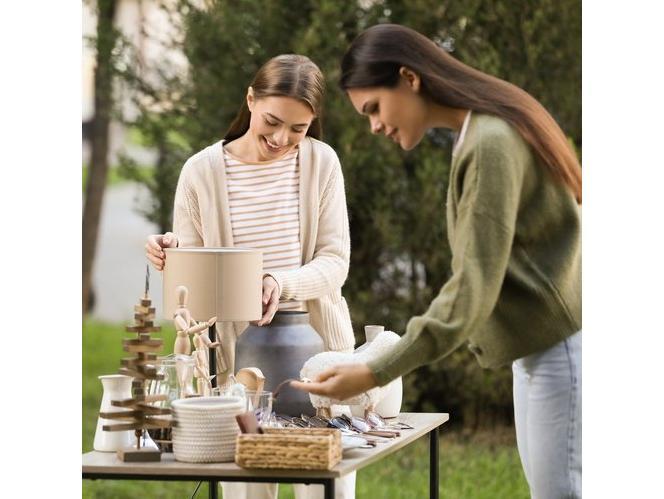
Tips For a Successful Yard Sale
Yard sales are a great way to convert items that you hardly ever use into cash that can be saved, donated, or put towards a large purchase. However, a successful yard sale takes a considerable amount of preparation and planning. Here are some tips on how to hold a great yard sale.
Set a Goal
First, it's a good idea to think about why you want to hold a yard sale. Are you hoping to generate income or use the sale to get rid of items you're no longer using? Having a goal in mind can help you decide what to sell, how to price your items, and how flexible you want to be with hagglers.
Choose the Right Date
The best days to host a yard sale are usually Friday and Saturday. Consider the first Friday or Saturday of the month, after most people receive their paychecks and have more money to spend. Try to pick a date and time when you expect the weather to be mild and dry. You can’t predict or control the weather, but you can do a little internet research to see which weekends have had the best weather historically.
Price Out Items as You Gather Them
To avoid rushing, don't price everything on the day before the sale. As you are collecting items to sell, you can create a comprehensive price list or go ahead and label each item with a price sticker. When pricing each item, think like your customers. They want every item to be at a steep discount.
Properly Advertise Your Yard Sale
Hang flyers and post online ads about the sale a couple weeks before it begins. You should also inform the people you know on social media a few days before the sale. Highlight any sought-after items that will be available in your sale, which can include furniture, specialty tools, collectibles, and toys. Make sure that you include the date and time of the sale as well as your full address.
Complete Preparations Early
In the week preceding the sale, gather as many tables as possible. If your friends or family can lend you a table, call them to ask well ahead of time. You should also have a cash box on hand with a wide variety of coins and smaller bills. Some additional items you may need include:
- Batteries
- Extension cords
- Light bulbs
- Calculator
- Chairs
- Cooler with drinks
- Hand sanitizer
- Pens
- Sold tags
- Paper or plastic bags
Make Sure All Items are in Good Condition
Every item you're selling should be in good, usable condition. Make sure that you include working batteries in electronic devices and pump air into any basketballs or soccer balls. Have someone on hand during the day to rearrange items and fold clothing so everything looks tidy and well cared for.
As long as you choose the right date, properly advertise the sale, and prepare for the event, you should avoid most of the problems that can occur when hosting a yard sale.

The Power of Pre-Approval
If you’re buying a home this summer, today’s housing market can feel like a challenge. With higher mortgage rates it’s essential to have a firm grasp on your homebuying budget. You’ll also need a sense of determination to find the right house and act quickly when you go to put in an offer. One thing you can do to help you prepare is to get pre-approved.
To understand why it’s such an important step, you need to know what pre-approval is. As part of the process, a lender looks at your finances to determine what they’d be willing to loan you. From there, your lender will give you a pre-approval letter to help you understand how much money you can borrow.
A pre-approval is an indication from your lender that they are willing to lend you a certain amount of money to buy your future home. Keep in mind that the loan amount in the pre-approval letter is the lender’s maximum offer. Ultimately, you should only borrow an amount you are comfortable repaying.
Basically, pre-approval gives you critical information about the homebuying process that’ll help you understand how much you may be able to borrow so you have a stronger grasp of your options. And with higher mortgage rates impacting affordability for many buyers today, a solid understanding of your numbers is even more important.
Pre-Approval Helps Show You’re a Serious Buyer
That’s not the only thing pre-approval can do. Another added benefit is it can help a seller feel more confident in your offer because it shows you’re serious about buying their house. And, with sellers seeing a slight increase in the number of offers again this spring, making a strong offer when you find the perfect house is key.
As a recent article from the Wall Street Journal (WSJ) says:
“If you plan to use a mortgage for your home purchase, pre-approval should be among the first steps in your search process. Not only can getting preapproved help you zero in on the right price range, but it can give you a leg up on other buyers, too.”
Getting pre-approved is an important first step when you’re buying a home. It lets you know what you can borrow for your loan and shows sellers you’re serious. Connect with your real estate professional and a trusted lender so you have the tools you need to purchase a home in today’s market.
Have question? I can help!
Let's connect today so you can learn about your options in this market.
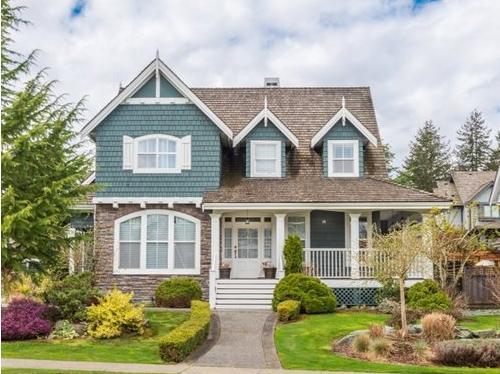
Falling Out of Love with Your House? It May Be Time to Move
Owning a home means having a place that’s solely your own and provides the space, features, and location you and your loved ones need. But what happens when your needs change? If this hits home for you, it may be time to make a move.
According to the latest Home Buyers and Sellers Generational Trends Report, the average person has lived in their current house for ten years. If you’ve been in your home for a while, think about how much in your life has changed since you moved in. Even if you thought it would be your forever home when you bought it, it doesn’t have to be.
Work with a local real estate agent to explore all your options in today’s market before settling for your current home.
That’s actually what a lot of homeowners are doing right now. A recent survey from Realtor.com finds that, of people who are considering selling in 2023, one in three are thinking about moving because their home no longer meets their needs. And according to the same report that’s consistent with this year’s top reasons for selling, which include:
- Want to move closer to friends or family
- Moving due to retirement
- Home is too small or too large
- Change in family situation
- Job relocation
If things in your life have changed, it may be time to make a move. And there’s good news: it’s still a great time to sell. Here’s why.
We’re in a strong sellers’ market. That means homes listed at market value and in good condition are getting attention from buyers and selling quickly. Lean on your expert real estate advisor for the best advice on getting your house ready to sell.
Your equity can power your next move. There’s a good chance you have a significant amount of equity right now thanks to record levels of price appreciation in recent years. When you sell, you can use that equity to help afford your next home!
In fact, 38% of recent buyers used the money from the sale of their previous home to cover the down payment on their next one.
If your home no longer meets your needs, consider selling it so you can find your dream home. Let’s connect so you can learn about your options.

Home Inspections for Sellers: What You Need to Know
What is a home inspection?
A home inspection is an examination of the condition and safety of a piece of real estate, often conducted when the home is being sold. A qualified home inspector will assess the heating and cooling system, water and sewage systems, other plumbing, and electrical work, and look for any potential fire or safety hazards.
Inspections and Repairs are Popular Again
During the housing market frenzy of the pandemic, many buyers waived inspections to be more competitive with their offer. However, a recent Realtor.com survey found that inspections and repairs are becoming popular again:
95% of buyers are requesting home inspections.
95% of sellers are making some updates or repairs prior to listing.
67% of buyers are asking for repairs as a result of the home inspection.
Most home sellers (86%) say they plan to spend money on major repairs or renovations to make their home more appealing to potential buyers prior to selling it.
32% plan to spend $10,000 or more.
9% plan to spend between $5,000 and $9,999.
5% plan to spend between $2,000 and $4,999.
The inspection is a major part of the home selling process. Let’s connect so you have an expert on your side who can help you determine the repairs and updates your house needs before you sell!

Peach, Feta And Pecan Salad
A healthy, quick summer salad
This salad comes together quickly – in about 10 minutes. It won't take you very long to prep all your ingredients. Give it a try when you want something fresh on these warmer days!
INGREDIENTS
- 5 oz bag mixed spring greens
- 2 peaches – sliced
- 2 oz of feta cheese – crumbled
- 1/2 cup of pecans
- 2 tbs minced red onion
- 4 tbs olive oil
- 2 tbs white wine vinegar
- 1 tps honey – 1 small squeeze
- 6 twists of black pepper from a pepper mill
INSTRUCTIONS
Wash and dry the mixed spring greens and set aside.
Slice peaches, dice feta and mince the red onion.
Whisk together olive oil, white wine vinegar, honey and black pepper.
Toss half the dressing over the mixed greens. Add all the rest of the ingredients to the mixed greens and toss with remaining dressing.
Enjoy!

5 BEAUTIFUL DECOR COMBINATIONS TO ADD VALUE TO YOUR BATHROOM
Some things are just meant to go together: macaroni and cheese, Pam Beesly and Jim Halpert, a bubble bath and a glass of wine. But when it comes to bathroom decor, some pairings are less obvious.
If you’re looking to liven up your look or add value to a bathroom in your home you plan on selling, the following design ideas are sure to provide some inspiration. Here are five dreamy bathroom design pairs made in heaven:
1. Natural wood cabinetry + black walls
If you have a natural wood vanity in your bathroom, this tip is for you. The painted black walls really make the wood tone pop. The mix of rustic wood and black walls is fast becoming the newest take on modern farmhouse decor. Lighter oak finishes are having a moment, and what better way to highlight them than with the dark contrast of black walls.
Get the look: Complement the light wood cabinetry in your bathroom by painting the walls Midsummer Night by Benjamin Moore.
2. Brick flooring + cream-color walls
Whether you start with the cream-color walls or the timeless brick flooring, there’s no denying the power of this decor combo. The design creates such a wonderfully warm bathroom with creamy walls and rustic flooring. The natural world is being brought into bathroom design lately to great effect: creamy natural colors and organic materials are all trending right now. Cream and beige tones have eclipsed gray as the neutral shades du jour.
Get the look: Get in on this trend by painting your bathroom walls Pink Damask by Benjamin Moore and installing herringbone tile that looks like brick (without the brick price tag).
3. Exposed beams + a Turkish rug
When you have a neutral-tone bathroom, lean on colorful, handwoven textiles to invigorate the space. We love the combination of the wood beams and the vintage Turkish rug. This combination of materials and textures creates an eclectic look that works for a variety of different design styles, from bohemian to modern.
Get the look: Shop for antique Turkish rugs on Etsy, or up the warmth in your bathroom with colorful washable rugs.
4. Marble wainscoting + a bronze mirror
Marble and metallics are a classic combination for the bathroom. Marble wainscoting adds a sense of sophistication and refinement to a powder room, while brass decor adds a touch of glamor. The result is a high-end and cohesive design that’s visually stunning, functional, and easy to maintain.
Get the look: Combine Carrara marble tiles with a bronze mirror for an opulent powder room.
5. Vintage vanity + geometric tiles
There’s nothing quite like pairing something old (like a vintage vanity) with something new (like a geometric tile backsplash). Using a vintage piece of furniture as a vanity is a great way to repurpose materials and bring true design cred to your space, while the geometric tiles climb the wall like a trellis and work to draw the eye upward.
Get the look: Pair your perfectly vintage vanity with these marble mosaic tiles.
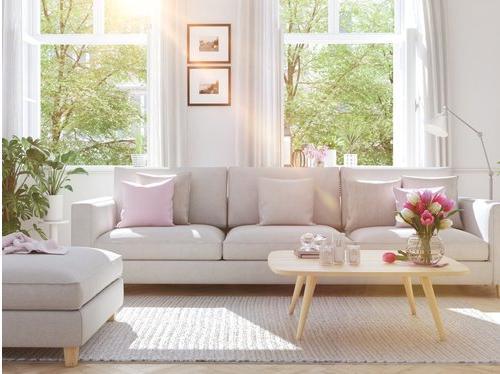
Get Ready: The Best Time To List Your House Is Now!
If you’re thinking about selling this spring, it’s time to get moving – the best week to list your house is fast approaching.
Real estate experts have looked at seasonal trends from recent years (excluding 2020 as an uncharacteristic year due to the onset of the pandemic) and determined the ideal week to list a house this year:
Home sellers on the fence waiting for that perfect moment to sell should start preparations, because the best time to list is the spring. If you’ve been waiting for the best time to sell, this is your chance. But remember, before you put your house on the market, you’ve got to get it ready. And if you haven’t started that process yet, you’ll need to move quickly. Here’s what you should keep in mind.
Work with an Agent To Determine Which Updates To Make
Start by prioritizing which updates you’ll need to make. Not everything needs to be done to sell your home, but an agent can help you choose what areas will show off your house in its best light.
If Possible, Plan To Have Your House Staged
Once you’ve made any necessary repairs and updates to your house, consider having it staged. According to the National Association of Realtors (NAR), 82% of buyers’ agents said staging a home made it easier for a buyer to visualize the property as a future home. Additionally, almost half of buyers’ agents said home staging had an effect on most buyers’ view of the home in general. Homes that are staged typically sell faster and for a higher price because they help potential buyers more easily picture their new life in the house.
Bottom Line
Are you ready to sell this spring? Let’s connect to plan your next steps. You can start by making a checklist of what you think your house needs to get ready. Then, we can work together to prioritize your list and move forward together. It wont be as daunting as you think!

Garden Trends to Revamp Your Landscaping
It’s an exciting time for gardeners. We’ve reached mid-spring and now is the time to start making our summer-garden plans. While it’s always important to touch up your garden this time of year, why not go a little bigger this time and give your landscape a complete renovation with these hot summer trends?
1. Go Bold
Plant dahlias such as the Coral Gypsy, Tempest, and Beach Bum varieties to bring bright color to your yard. Planting summer-cypress adds serious pops of color, and by adding some of your standard favorites, you can perfectly complement the bright reds. For year-round boldness, plant some hardy succulents or evergreens in large, brightly colored planters that make a statement.
Wildflower and perennial meadows also create a casual style of planting. Gardens are getting more natural and less manicured, so you should think about how you can keep your arrangements loose and less structured, which will make your garden standout. Think like the Japanese, who are known to embrace garden imperfections, asymmetry, and incompleteness.
2. Try Textures
Silvery dusty miller and ruffled ferns are in style this season. Bounce colors off one another with orange lilies and purple verbena. Contrast shapes by planting things like yucca and lantana. Don’t forget those hanging baskets, either. Start your hanging basket with a tall statement piece, surround it with something that fills the gaps well, and finish with some color to spill over the edges.
3. Get Cooking
Spending more and more time outside, including time to make a nice meal, is nothing new. Outdoor kitchens are rising in popularity, especially for homeowners who entertain a lot. When designing your outdoor cooking space, try to take your design choices in a different direction than your indoor kitchen to keep the space feeling unique. Contrasting the indoors with the outdoors is what will make your space feel truly refreshing.
4. Get Out
A place to relax within your garden can feel like a vacation, especially for those who don’t have the time for an official trip. Creating a lovely area to relax, read, or meditate is gaining in popularity as people become more aware of the need to decompress. Find a secluded space in your garden and set up some of your favorite chairs and a table. Or if you want to go big, build a little open-air art studio situated around or within your favorite plantings. A garden is a great place to refresh after a long day.
5. Give Back
You can get much more enjoyment out of something when you share it. Give to your neighbors and give back to the planet. Look into how you can make your garden a Certified Wildlife Habitat to benefit wildlife. Donate some of your fresh produce to your local food bank or share with your neighbors to really build a feeling of homeliness. Find natural solutions for weeds, slugs, and snails. Include plants that attract pollinators. Enhance your soil with organic compost by creating your own composter. It’s simple and keeps a lot of waste out of the garbage piles and puts it to work in your garden. You can also buy packaged or bulk compost at most home and garden stores.

April Showers Bring May Flowers!
Many people use this as a month to focus on their own garden or lawn and others use it as an opportunity to beautify their community. However you want to usher in the warmer growing weather, these are some ideas for you!
Organize a Neighborhood Clean Up
Gardening extends beyond your backyard. It’s important to take proper care of your neighborhood and community too! Rally up all your neighbors and friends and get to work. You can walk the streets and collect trash, plant flowers in heavily populated areas, connect with local charities and create a community garden. The opportunities are endless, but the more projects you complete together the better your community will look.
Start a New Gardening Project
Now is the perfect time to start a new project in your garden! Get lost on Pinterest till you find a project that stands out to you. If you aren’t much of a DIY pro, you can start with something as easy as scrubbing down your lawn furniture. More advanced projects can include building your own flower beds, trimming overgrown shrubs and even planting your own vegetable garden.
Take Time to Enjoy your Garden
Now that the weather has changed for the better, it’s important to take advantage of that beautiful garden in your backyard. Have some friends over for a picnic and put those homegrown veggies to use. Gardens are also a great place to relax and catch some vitamin D.
Start an Indoor Herb Garden
Don’t have a yard, but still want in on the action? Indoor herb gardens not only provide fresh herbs at your fingertips, but also fill your home with fragrance and greenery. Most herbs can be grown indoors like basil, chives, mint, oregano and parsley. Growing your own herbs makes cooking at home easy and healthy. Be sure to do some research on the best type of herb garden for your space.
Enjoy a Local Farmer’s Market
Farmer’s markets are a great way to eat organic fruits and veggies without the hassle of going to a grocery store. By shopping at your local farmers market, you will eat fresh, nutrient-rich foods for an affordable price. Farmers markets are a great way to bring communities together and support local small businesses and farms. Check out your local market today to see what you’ve been missing.
Start Composting
One person’s trash is another person’s treasure. Fruit and vegetable peels, coffee grounds, and yard waste such as grass clippings can be used in a compost pile. Compost improves soil structure and provides nutrients for plants, all from waste you typically throw out.
The possibilities are endless when it comes to enjoying the warmer weather. Regardless if you choose a small task or a big task this spring, getting outside and enjoying the environment and your community has hug health benefits. Why wait for the summer months to begin?

How to Dye Easter Eggs
If you're dyeing Easter eggs this year, follow these six simple steps for adding a coat of colour to those hard boiled eggs. Beautifully dyed Easter eggs are a surprisingly simple DIY project. And you don't have to rely on store-bought kits to get colourful Easter egg perfection. With a few key tips and tricks (i.e., let your hard boiled eggs cool before you dye them), you can ensure an Insta-worthy finish every time.
What You Need to Dye Easter Eggs
- Hard boiled eggs
- Paper towel or newspaper
- Bowl or cup deep enough to completely submerge an egg.
- Tongs, egg dipper, or slotted spoon
- ½ cup boiling water
- 1 teaspoon white vinegar
- Liquid food colouring (about 20 drops per colour)
How to Dye Eggs
1. Protect your surface by covering with a sheet of newspaper or paper towel.
2. Use cool hard boiled eggs.
3. Fill container with enough water to cover the egg, one teaspoon of white vinegar, and about 20 drops of food colouring. The more food coloring you add, the darker the color of the egg will be.
4. To create unique patterns on the eggs, use rubber bands, wax, crayons, or waterproof tape to mark off stripes or designs where you don't want the dye to hit.
5. Place your egg on a slotted or regular spoon and dunk, turning occasionally so both sides get colour. Keep your dyed egg in the liquid for up to 5 minutes. The longer you leave your egg in the dye bath, the more vivid the colour will be. You can also dip only part of the egg in one colour, then switch to another colour to create a multi-colored effect.
6. Carefully remove the egg and set it aside to dry. Once the eggs are dry, you can apply stickers, washi tape, gold leaf, or other decorative elements to finish off the look.
Have fun getting creative!

Refresh for Your Home
Warmer Months are Coming!
Now that Spring is on our doorstep, it's the perfect excuse to refresh and brighten your home. It’s time to put away the faux fur throws and plaid wool pillows and bring in some vibrant colours and light, airy fabrics, and textiles. To help you freshen your home this Spring, we provided you with a list of ideas to freshen up your space!
Clean Windows
It’s finally time to let some light in! Now that the sun is shining, it is important to clean and open your windows to let the fresh air in. Washing and dusting your windows will help decrease the dirt and debris blowing through your house when it comes time to open the windows. During this time, if you notice your window screens have holes or rips it may be time to purchase and install new screens. If you’re feeling extra fun, you can even purchase new curtains to make your window space pop with color!
Check HVAC System
What’s worse than a 90-degree day with no air conditioning? To ensure that nightmare doesn’t happen to you, check your home’s HVAC system to ensure it’s working well before temperatures get too hot. That way if you run into a problem, you should have more than enough time to have a professional check it out for you.
Put Seasonal Stuff in Storage
Simplify your life! Store away items that aren't useful in the warmer months, such as blankets, thick Afghans, and heavy quilts, so that you can make space for things that are! Lightweight throws are the perfect spring/summer sofa or chair accessory because you can curl up in them comfortably, even when it's hot outside!
Add Some Greenery/Fun Accessories
Flowers and plants are your best friends when it comes to bringing charm, beauty, and fragrant smells into your home. Pull out your vases, and stock fresh flowers of all kinds and colours in every room that you can! You can even get faux plants if you don’t want to buy the real thing!
Additionally, you can brighten up your space with fun warm weather accessories. Beachy wall art, lightly scented candles and fresh fruit arrangements are all great ways to decorate for the sunny months ahead.
New Bedding
Bulky, heavy, warm bedspreads in the summer are bad news. Thick bedding ends up on the floor anyway because it's too hot to try to sleep with. Put it away for the next few months and use a thin down comforter for a cooler night's sleep. And by the way, if you have access to simple white bedding, use it! It's the perfect peaceful bedroom colour for the warmer months.
The best way to celebrate the season change is revamping your space. Hopefully these tips will help you brighten your space for spring and the coming summer!

10 Home Renovation Trends That Could Hurt Future Sales
Spring is the time for many major home remodeling projects. From installing new flooring to upgrading your porch or patio to any other number of home upgrades, warmer weather seems to signal the perfect timing for making renovations.
We also know that spring is a prime time for selling a home. While many buyers love a few upgrades, it pays to choose carefully when it comes to your renovations. Why? The design choices you make might not align with every buyer’s taste, which could hurt your potential for selling in a competitive market.
Here are 10 trendy renovation choices to avoid if you’re planning to sell your home in the future:
1. Overdoing it in the kitchen. Yes, granite countertops are appealing to many buyers. However, high-end appliances might not increase your resale value as you would hope. Sure, they are great if you’re planning to use them for the long term, but they probably won’t give your home an edge over others on the market.
2. Being overly bold with your paint choices. Who doesn’t want to follow current trends when it comes to paint colors? But if you’re going bold in a lot of parts in your home, you could be creating more work for yourself when it comes time to sell. Loud paint colors can be covered up, but it can be a time-consuming and costly process.
3. Forgetting about your curb appeal. Don’t get so caught up in renovating the interior or exterior of your home that you forget about your lawn and landscaping. Remember, your curb appeal is one of the first things that buyers notice about your home. Give it proper attention when you’re making renovations too.
4. Leaving out lighting. Like finely pruned landscaping, great lighting can be an awesome selling point in a home. So, if you’re doing a major design overhaul in any room, don’t forget about upgrading your lighting. Whether it is a new fixture or adding energy-saving bulbs, good lighting can increase your home’s appeal when it comes time to sell.
5. Buying on impulse alone. Typically, there are many parts to a remodeling project. Think about a kitchen renovation. You might choose new flooring, cabinets, countertops, appliances, and hardware. Be sure to coordinate your choices so that you’re creating a fluid look throughout the project. Otherwise, your result could be disjointed and even unappealing to buyers.
6. Only focusing on appearance. Together with coordinating design choices is making sure that your stylistic upgrades are supported by structural renovations too. It is one thing for your home renovation to look good, but if it negatively affects your home’s structure, it could cost you far more money – and a potential home sale – in the future.
7. Skimping on good materials. During a home renovation, you want to get the most for your money. But that doesn’t mean you should buy cheap materials simply to achieve a certain look. While they might be appealing at first, lower quality materials probably won’t last, which could cost you more in the long run.
8. Choosing the cheapest contractor. Like good materials, a good contractor can make your home renovation project last. When you’re ready to renovate, be sure to choose a reputable contractor. Otherwise, you could be paying for repairs – or a total redo – when it comes time to sell.
9. Thinking you don’t need a permit. This is especially true if you’re completing your spring home renovation projects by yourself. Be sure to check local regulations before demo day. If you make renovations without a needed permit, you could be fined or even asked to tear down your work!
10. Being the biggest home in the neighborhood. Finally, remember that while your renovations are meant to add beauty and value to your home, they do not need to make it the showiest home in your neighborhood. In fact, if your home is the biggest or most expensive in your neighborhood, you might not recoup your investments when you go to sell.
The bottom line when it comes to your spring home renovations: be sensible if you’re planning to sell in the future.
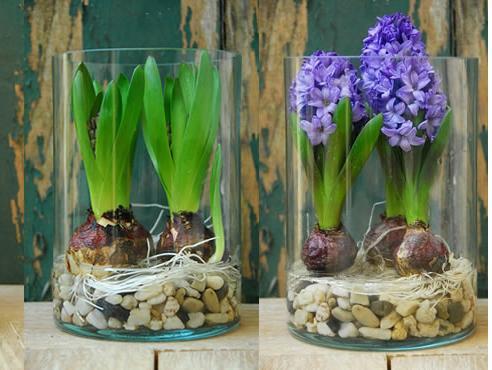
Forcing Spring Inside
No winter lasts forever; no spring skips its turn.
Forcing bulbs is a wonderful way to bring spring into the house a little early. It is easy to do, whether you are forcing bulbs in water or soil. And a great way to feel like spring is on its way!
Almost any spring blooming bulb can be forced to bloom indoors, but some spring blooming bulbs are more popular for bulb forcing. Some popular spring bulbs to force are
- Daffodils
- Amaryllis
- Paperwhites
- Hyacinth
- Tulips
- Crocus
With the exception of amaryllis, unless you have bought flower bulbs that have been specifically prepared for forcing, you will need to prepare them. Place them in a cold place, between 35 and 45 degrees F. (2-7 C.) for 10 to 12 weeks. Many people use either their refrigerator in the vegetable drawer or an unheated garage to do this. This is called pre-chilling. Once your flower bulbs have been pre-chilled, you can start forcing bulbs indoors in either water or soil.
When forcing bulbs in water, first choose a container to use for forcing. You can buy specific vases called forcing vases to grow your flower bulb indoors. These are vases that have a short, narrow necks and wide mouths. They allow the flower bulb to sit with only its roots in the water. You do not need a forcing vase to force a bulb to bloom in water. You can also use a pan or bowl filled with pebbles. Bury the bulbs halfway into the pebbles, with the points facing up. Fill the pan or bowl with water so that the lower quarter of the flower bulb is in the water. Make sure that the pan or bowl always has water.
Flower bulbs can also be forced inside in pots filled with soil. Fill the pot with a light potting mix. Do not use soil from your garden. Plant the flower bulbs you will be forcing half to three-quarters of the way deep into the pot. The pointy tops of the bulbs should be out of the soil. Water the bulbs and keep the soil moist.
Keep your planted bulbs in a cool place, 50 to 60 degrees F. (10-60 C.), until it starts to form leaves. This will help it to form a more compact flower stem, which is less likely to fall over. Once leaves appear, you can move the flower bulbs to a warmer location. They prefer bright, indirect light. Make sure to keep your forced bulbs watered. The roots should always have moisture. Once your forced bulbs have finished blooming, you can cut the spent flowers off and plant them outside.

Is Our Real Estate Market Due for a Big Correction?
The market has slowed from it staggering highs of 2021. But it still remains to be seen where home prices will go from here. Everyone is speculating.
The average price for a home in New Tecumseth was $800,668 in January 2023, according to the Toronto Regional Real Estate Board. That’s down 1.2 per cent or $9,968 from December 2022 and down 30 per cent or $342,880 compared to January 2022.
There were 35 home sales in New Tecumseth after an average of 29 days on the market and 105 active listings at the end of January. Sales were down 14.6 per cent and active listings were up 275 per cent compared to a year ago.
The continued interest rate increases, as well as potential economic slowdown, are offering new opportunities to engage in the market for buyers and sellers because of improved affordability.
For buyers, this includes having fewer competitors, reduced prices and an increase in choices in the market. Meanwhile, sellers will have a trade-up advantage, reduced competition of listings, a stronger ability to re-locate to the suburbs.
Looking for your opportunity to buy or sell in this changing market needs a knowledgeable guide. Have questions? I'd be happy to help!
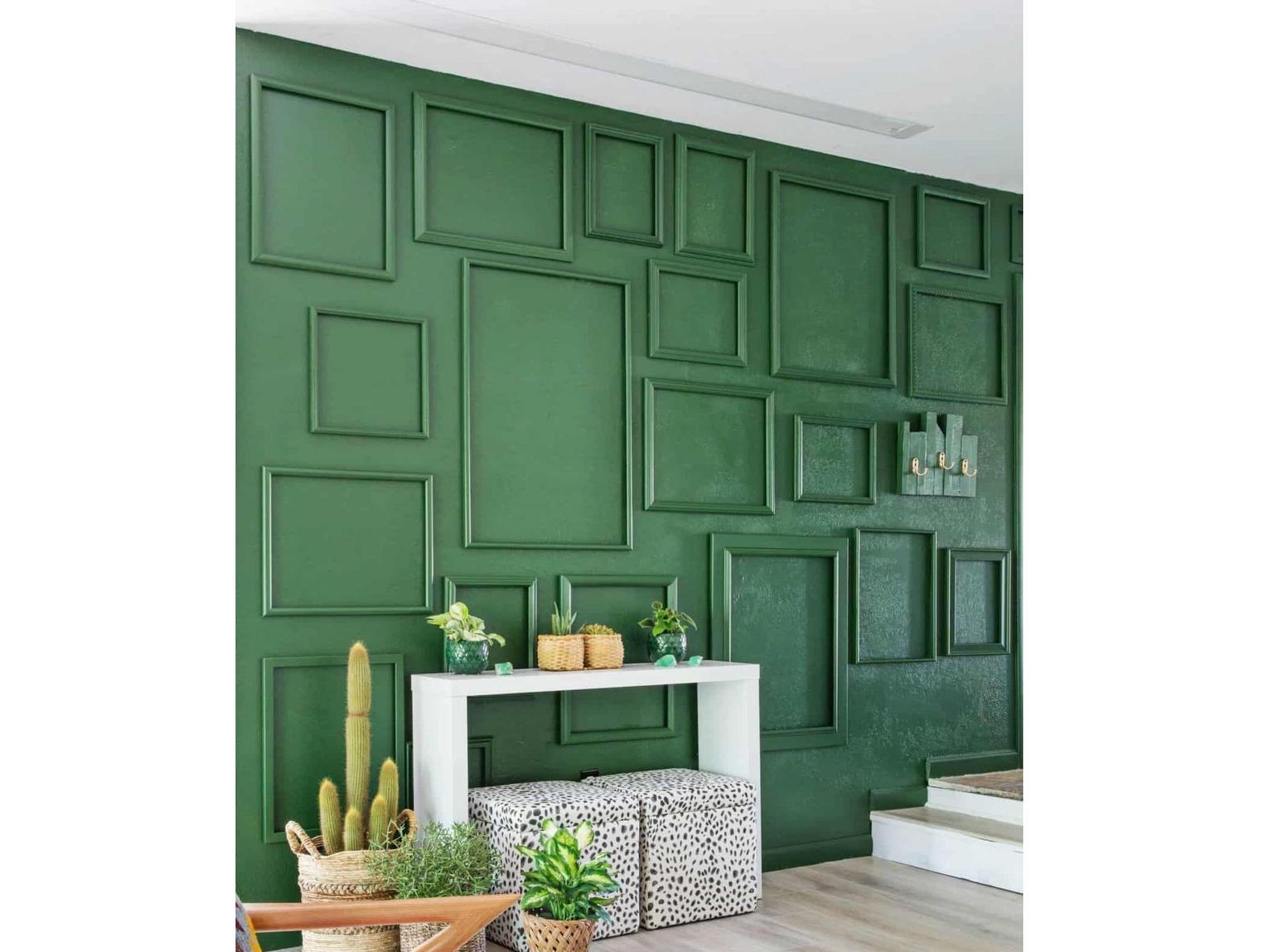
Would You Try a Frame-Filled Accent Wall?
Bold DIY project adds drama to any space!
Sometimes we need a little drama in our lives. Don't let fear of making mistakes stop you from installing a gallery wall in your home.
Create a statement accent wall by hanging frames of different shapes and sizes, then cover everything with a fresh coat of paint — preferably something bold. Make sure to mix and match frames, using both horizontal and portrait orientations to add excitement.
Craft stores, antique and secondhand retailers, as well as flea markets are all excellent resources for finding a variety of frames that speak to you.
Once you have established which pieces you'll be using, it's time to come up with a layout that works for you. Gallery walls may look effortless, but they take planning. So you will want to use the largest frames as an anchor piece and let the design shape the overall display.
What do you think? Would you try a bold gallery wall?

Tips For Online Home Searches
five tips to help you get your online home search started
Today’s home searches do not begin by simply driving by a “for sale” sign and stopping in to view a home. In many cases, buyers begin searching for their next properties from the comforts of their current homes.
In fact, online home searches have become such a reality for today’s home buyers that listing photos have become an integral part of curb appeal. If you’re planning to start your new home search online, how can you be sure you’re finding a home that will match your needs?
Here are five tips to help you get your online home search started:
1. Know your needs and wants list.
One major difference between searching for homes online and scouring local neighborhoods for available homes is the sheer number of homes available. If you don’t have a clear idea of the features you want to find in a home, you might spend a lot of time sorting through available inventory online to find even a couple homes that meet your desired criteria. Spend some time before you begin your search and determine the home features that are most important to you. Focus your online efforts on finding homes that meet all or most of those criteria.
2. Use available tools to narrow your home search.
Once you have a good grasp of the home features you’re looking for, allow online search capabilities to assist you! Use search filters to eliminate homes that are not in your price range, or those that do not have the features you’re looking for. Want a single-family ranch with at least three bedrooms, a finished basement, and a little yard space? Use search filters to find homes that might meet all or most of those wants.
3. Be sure to do neighborhood research.
You can learn a lot about a home through an online search. Once you find a home or homes that might be right for you, be sure to take time to learn about their neighborhoods too. Check out what kinds of restaurants, entertainment options, and amenities are nearby. Learn about the schools, commutes and crime rates too. Even if a home seems to have everything you’re looking for, it’s location might not be right for you and your family. Research any neighborhoods you might not be familiar with when you’re searching online.
4. Don’t believe everything you see.
A picture is worth 1,000 words, right? When it comes to an online home search, buyers might need to make sure those 1,000 words are accurate. Professional listing photos can paint an incredible picture of a home. And kudos to all sellers who represent their homes with awesome listing photos. But, buyers beware, seeing really is believing when it comes to a home. Let online photos draw you into a home, but take the next step and schedule a showing before becoming too captivated. Make sure the real thing lives up to the online representation during your home search.
5. Hire a professional to guide your search.
An online search is a great place to start looking for a new home. Once you find a home or a few homes that you’re interested in, allow a professional real estate agent to schedule showings for you. Once you share the homes you’re interested in with your agent, he or she might be able to point you to other homes that meet your desired criteria too. Of course, your agent will also represent your needs when it comes to negotiating a price, working with inspectors and other service professionals, and helping you get all the way to closing.

Beat Cold and Germ Season at Home
You might have noticed that subtly longer days and milder temperatures have been creeping back onto the scene lately. It’s true, spring is on the horizon. But we’re not in the clear just yet. In fact, in addition to those days of sunshine and fresh air we’ve been treated to recently, many of us also have been battling end-of-season cold and flu germs.
Once germs infest your home, they typically take a turn in each member of your family. To get your crew through to spring’s fresh air, here are eight ways to keep your home safe from germs:
1. Set (and keep) a cleaning schedule. Our first and best defense against germs is to keep a clean house. Of course, on top of your work and school schedule, home cleaning duties can be overwhelming. To make sure you’re not feeling like every Saturday must be devoted to cleaning your house from top to bottom, set a cleaning schedule where you tackle a task or two each day. This way, cleaning your home will be less of a chore—and more about keeping out germs that can make you sick.
2. Change your air filters. This chore is on every seasonal home maintenance task list out there. Though it might seem unnecessary at times, changing your HVAC system’s filter can help keep you safe from harmful germs. So, instead of dreading this regular home maintenance task—just make sure you do it on time each quarter.
3. Circulate the air in your home. In winter, there can be a major lack of fresh air in our homes. Combat stagnant air by continuing to run your ceiling fans throughout the season. This will help improve your indoor air and keep those flu and cold germs from settling in your home.
4. Increase indoor humidity. Speaking of improving your indoor air quality in winter, make sure you invest in a humidifier for your home. The moisture in the air can help prevent sinus infections and other germs from manifesting.
5. Start spring cleaning early. Home cleaning tasks like vacuuming and dusting are easy to remember on a weekly basis. However, did you know that regularly wiping down your blinds and ceiling fans can help to prevent germs from finding a resting place in your home? Instead of saving these tasks for spring cleaning, tackle them before the warmer season arrives.
6. Always put the toilet seat down. Here is an easy defense against flu and cold germs—and any other germs for that matter. Simply keep your toilet seat down. Lowering the lid before you flush and when your toilet is not in use will help keep germs away from you and your family members.
7. Look at light switches, doorknobs, and remote controls. From your smartphone to your remote controls to doorknobs and beyond, so many things in our homes involve our touch. Take a look at your bathroom light switch for instance. You might be surprised at how much dirt and dust can compile in such a small area. Make it a habit to wipe down any devices, doorknobs, and other hand-friendly parts of your home.
8. Wash your hands. It’s advice that probably has come from every parent out there. Routinely wash your hands to prevent them from collecting and spreading any germs throughout your home. The advice is no different during cold and flu season. Step up hand-washing efforts around your home to help keep germs out.
The moral of this healthy home story? Give your home a little extra TLC – cleaning, maintenance, and care – to be sure you and your family stay germ-free for the remainder of cold and flu season. A healthier season will be here in no time at all!

Bakery Style Chocolate Chip Cookies
Nothing smells better than freshed baked goods!
Want to add a little warmth to your home, try this chocolate chip cookie recipe and have the smell of fresh baking in your house!
Ingredients:
3 cups (380 grams) all-purpose flour
1 teaspoon baking soda
1 teaspoon fine sea salt
2 sticks (227 grams) unsalted butter, at cool room temperature (67°F)
1/2 cup (100 grams) granulated sugar
1 1/4 cups (247 grams) lightly packed light brown sugar
2 teaspoons vanilla
2 large eggs, at room temperature
2 cups (340 grams) semisweet chocolate chips
Directions
Preheat oven to 350ºF. Line baking sheets with parchment paper.
In a medium bowl, combine the flour, baking soda, and salt.
In the bowl of an electric mixer, beat the butter, granulated sugar, and brown sugar until creamy, about 2 minutes. Add the vanilla and eggs. Gradually beat in the flour mixture. Stir in the chocolate chips.
If time permits, wrap dough in plastic wrap and refrigerate for at least 24 hours but no more than 72 hours. This allows the dough to “marinate” and makes the cookies thicker, chewier, and more flavorful. Let dough sit at room temperature just until it is soft enough to scoop.
Divide the dough into 3-tablespoon sized balls using a large cookie scoop and drop onto prepared baking sheets.
Bake for 11-13 minutes, or until golden brown. Cool for 5 minutes before removing to wire racks to cool completely.
Although I prefer cookies fresh from the oven, these can be stored in an airtight container for up to 3 days.
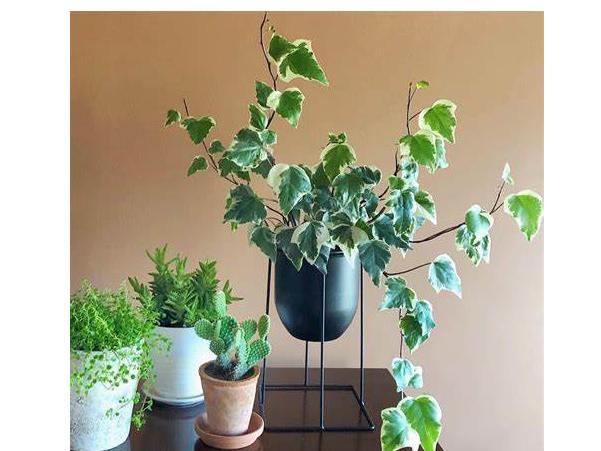
10 Winter House Plants for Your Home
to add fresh energy to your space
Cold weather tends to keep some of us indoors during the long winter months. But there is some hope in battling the cabin fever that can make us feel a little blue. Houseplants are a great way to bring some fresh air and greenery into your home during winter.
What better way to start combatting cabin fever than by adding a few houseplants to your home? Here are 10 easy-to-care-for houseplants that can help bring fresh life to your home this winter and all year long:
1. Garden Mums: Still have some mums left over from this fall? Keep them around to help you get through the cold this winter. They’re colorful and they’ll help provide cleaner, fresher air in your home during any season.
2. Spider Plants: This is one type of spider you’ll always be glad to find in your home. Spider plants add great color and grow well with little care. In fact, this plant doesn’t need much light and is even happy when its soil dries out between watering.
3. Ficus Trees: Want to add some height to the greens in your home? Bring in a ficus tree that could grow to be taller than you! This houseplant does like a lot of light, but it can grow well with little water.
4. Aloe Plants: You probably already know that this plant’s gel can help soothe burns and cuts. But did you also know that an aloe plant can help soothe cabin fever? This sun-loving plant will help clean the air in your home in addition to showing off its bright green hue.
5. Peace Lilies: Not only will this plant help freshen the air in your home all year long, but its flowers will also be a welcome sight each summer. Peace lilies do well in shady areas and will droop a bit to let you know they need a drink of water.
6. Bamboo Palms: Though it is important to make sure this houseplant gets lots of water, the bamboo palm grows well in both sun and shade. It can last in a home for years, which makes this houseplant an excellent addition to your regular décor.
7. Dragon Trees: If you’re looking to add more than just fresh green to your home, consider the dragon tree. Its leaves can be either green or purple! The dragon tree doesn’t need much light and will happily live indoors or outside once warmer weather arrives.
8. Chinese Evergreen: Also known for its vibrant colors, the Chinese evergreen grows well with little light. It is great for most homeowners but is one that pet owners might want to stay away from as it can be toxic to our four-legged family members.
9. Snake Plants: Don’t be turned away by this houseplant’s name. The snake plant can be a beautiful addition to your home décor. The fact that it is easy to care for doesn’t hurt either! This plant does well in dry conditions with some sun and occasional water.
10. English Ivy: With just a little water, a little sun and a little shade, an English ivy plant can thrive in your home all winter long. In fact, it can live for several years. Or, once the weather breaks, you could transfer this houseplant outdoors to welcome spring.
Bring a little green into your home on these dreary winter days by picking up an easy-to-care-for green or two for your home decor.

Buying a Home with Friends:
Conversations to Have Beforehand
Some of them have been around since you were a child. Some you may have found in college. Some may even be in your neighborhood or at work. No, I'm not talking about your sweater collection—though sweater season is in full swing. I'm talking about your friends. You know, the people who you rely on, confide in and maybe even vacation with.
You probably have no reservations about sharing secrets with your friends, but have you ever considered sharing a mortgage with them? It is not uncommon for friends to join forces to take on a second mortgage for a vacation home or investment property. It seems like a no-brainer, right? You’ve already vowed to be friends forever. A 15-or-30-year mortgage should be no problem
However, even the most maintenance-free friendships can face some tough times when it comes to sharing a home purchase. That is unless both parties are prepared for what co-ownership may bring. If you’re considering buying a second home with a friend, here are three major conversations you must have first.
1) How will you split the costs?
Unless you and a friend are planning to pay for a second home with cash, you’ll both be responsible for making monthly mortgage payments on the property. And, no, splitting a mortgage is not like splitting the bill for a night out. Having a conversation about fees like the down payment, closing costs and monthly mortgage payment is crucial before you even begin to consider looking at homes together.
While you’re chatting, don’t forget to include other monthly homeownership fees like utilities, regular maintenance, homeowner association dues or other services.
It is also important to bring up potential scenarios like plumbing issues, roof leaks or other home damage. How will you split all of the certain costs that come along with owning a home?
2) What will happen if someone is unable to hold up their end of the deal or wants to get out of the mortgage?
Any conversation about the potential costs of owning a second home must be accompanied by a conversation about what will happen in the event that one or both parties is unable to make their payments or wants to leave the agreement altogether.
Though this conversation may not be as fun as reminiscing about your long history together, it is a must-have talk before you can confidently enter a home purchase with a friend.
With all the excitement of potentially owning a vacation home or investment property, who wants to get mired down by thinking about the negative aspects of sharing a mortgage?
But, hard times happen for everyone. Before they happen in your blissful home-buying experience, have a plan. Will one person take over the entire mortgage payment? Will you be forced to sell the property? Make sure you consider the “what ifs” before you and your friend are forced into an uncomfortable situation.
3) How will you use your new property?
Once you get the tougher financial conversations out of the way, you can begin to consider the possibilities of what it will be like to own a second home with your friend. If you’re planning to purchase the home as a vacation property, you’ll need to decide if you’re going to split time there, vacation together or rent it out on a seasonal basis.
If you and a friend are looking to buy a second home as an investment property (or if you’re planning to rent out that vacation home), you’ll need to draft a rental agreement, plus decide how you’ll deal with tenants and their issues. You’ll also need to map out a plan for marketing and maintaining your property so that it continues to be a worthwhile investment.
Are you prepared to have a few tough financial conversations with a friend? Are you also prepared to face a few certain disagreements along the way to happy homeownership?
If you confidently answered “yes,” you—and your friendship—may be ready to stand the test of owning a second home together!

Warm up this winter with a cozy bowl of soup
Warm up even the chilliest winter night with a cozy bowl of this butternut squash soup. This recipe is super easy.
Ingredients
1 tablespoon olive oil
1 large onion, chopped
3 garlic cloves, minced
1 medium butternut squash (3 pounds), peeled and cubed
4 cups vegetable broth
3/4 teaspoon salt
1/4 teaspoon pepper
1/2 cup heavy whipping cream
Optional: Additional heavy whipping cream and crispy sage leaves
Directions
In a large saucepan, heat oil over medium heat. Add onion; cook and stir until tender. Add garlic; cook 1 minute longer.
Stir in squash, broth, salt and pepper; bring to a boil. Reduce heat; simmer, covered, 10-15 minutes or until squash is tender. Puree soup using an immersion blender. Or cool slightly and puree soup in batches in a blender; return to pan. Add cream; cook and stir until heated through. If desired, garnish with additional heavy whipping cream and crispy sage.
Enjoy!

Interior Design Trends in 2023
Trends being revealed for 2023 are focused on sustainable, natural materials, as well as objects that hold meaning, or memories. The pandemic induced a need to update and beautify our homes, but it also had us evaluating meaning and value behind our choices.
There has also been a greater emphasis on making our homes feel calm and cozy in the face of so much global uncertainty. As a result, we’re seeing a pull toward tranquil colour schemes, a pairing down of clutter to highlight our most meaningful objects, and a use of sustainable material that are kinder to the planet.
Because of the trend muted colors are coming into focus, with inspiration being drawn from nature. Think outdoors brought indoors, with warm daylight, natural wood tones and earthy greens.
If the last three years has taught us anything, it is that life can change in the blink of an eye. Adaptable living spaces that can be easily converted for multiple use are the key going forward.
Perhaps one day you want to use that little corner of your living room as music area, and the next day you want to use it as a home office. Or maybe your extra room needs to double as your yoga studio and a guest space.
Trends here to stay in 2023 are focused on earthy and earth friendly materials, as well as a return to objects that hold meaning as a way to beautify our living spaces.
